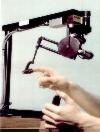 Feeling Mathematics
Feeling Mathematics Feeling Mathematics
Feeling MathematicsThe goal of this project is to develop a haptic environment within which a person can feel mathematical functions, and, in general, two and three dimensional data plots. The sense of touch is the only active sense that can be used to explore our environment, while vision and hearing are passive senses since they cannot act upon the environment. Haptic interfaces provide an additional input, and combined with visual and aural inputs, can make human-computer interaction a more intuitive. This project is directed towards individuals who are visually impaired. For blind people, haptic interfaces provide a medium to interactively explore information that is typically displayed graphically as a line or surface plot. Thus, scientific information is made more accessible, in addition to virtual environment experiences.
The device being used for this project is the PHANToM Haptic Interface from SensAble Technologies, Inc. in Cambridge, MA. It is a high resolution, three degree of freedom force feedback mechanism with a maximum exertable force of about 8.5 N. There is also a stylus that can be used in place of the thimble seen above.
To create a more realistic environment, and also to convey more information
about the environment, friction and texture models are added to objects.
Without these additional surface properties, all objects feel "slippery"
like ice. Friction models generate forces tangential to the surface, and
opposite the direction of travel. We have implemented models for Coulomb
friction (static and kinetic), viscous friction (proportional to velocity),
and drag friction (proportional to squared velocity). The PHANToM does not
have force sensors, however, so the force applied by the user, to determine
the Coulomb friction force, must be estimated from the position change and
the normal force (a function of the displacement of the haptic interface
position into the surface). Adding textures, though, is more complicated.
The approach we have taken is to perturb the surface normal vector, which
effectively creates the haptic illusion of feeling a textured surface. The
texture force vector can be computed from a deterministic or stochastic
function, or a combination of the two. By filtering white noise added to
a deterministic function, numerous random and pseudo-random textures can
be generated on haptic surfaces, and they can also be generated in a region
of space (i.e., the texture force is the only force acting on the user as
the haptic device is moved through space). Textures and friction can then
be used in a haptic environment as colors are used in a graphical environment.
For example, the variance of the texture could be modulated by the magnitude
of the surface, so that a higher magnitude will have a rougher texture.--Jason
Fritz, Applied Science & Engineering Laboratories
Scientific Visualization (Conceptualization)
URL of this document: http://www.asel.udel.edu/
robotics/newsletter/fallwin96/math.html
Last updated: February 6, 1997
Copyright © Applied Science and Engineering Laboratories, 1997.